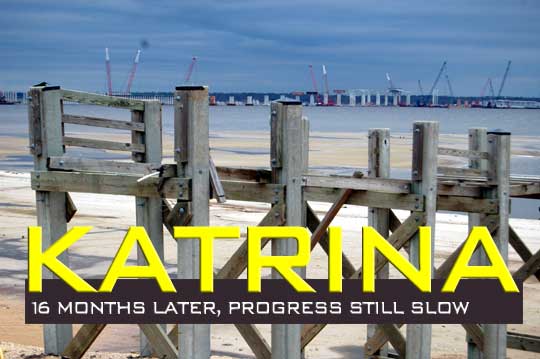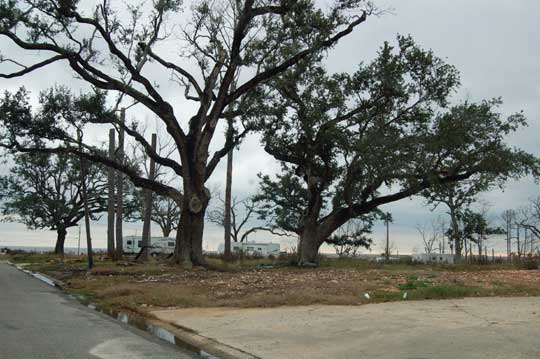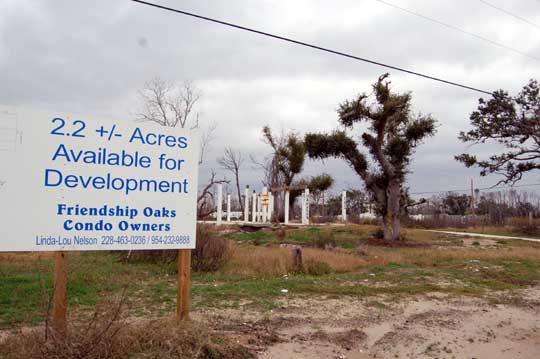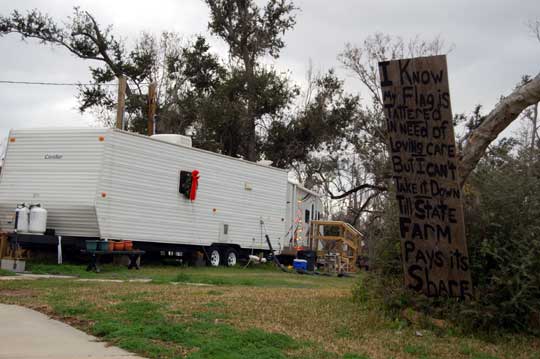
In August of 2005 Hurricane Katrina nearly obliterated two towns along the Mississippi coast where both Annie and I had lived in years past. In Bay St. Louis buildings that had withstood hurricanes for decades crumbled. The town of Waveland made national news as the "town that disappeared." From the beach to the railroad tracks a half mile inland, an area once filled with homes and businesses, nothing was left but concrete slabs, pillars, and piles of rubble. Hundreds of buildings had been swept off the land by hurricane winds and an incredible 25-30 foot storm surge. Coleman Avenue looked like Hiroshima after the blast. Further inland, most homes were left standing but badly damaged, many flooded to the roof lines. People lived in tents for many weeks until the FEMA trailers, temporary housing for the homeless homeowners, finally arrived.

Almost a year and a half after the storm, along miles of beach, there is just one house that has been rebuilt, with one or two more under construction. The thing that strikes you as you drive along the beach is the sense of desolation. You see empty lots, some with FEMA trailers parked on concrete slabs, but no one seems to be living in them. I drove for miles without seeing another person except in the two or three cars that passed me on the road. Later I saw a person walking about. It was a tourist like me, taking pictures of the emptiness. The photo above is from Lafite Drive, about a block back from the beach where my family lived in the 1960's. When I was four years old my father nailed a wooden ladder up against the oak tree on the right, making me a sort of tree house. The house we lived in at 105 Lafitte Drive was destroyed in Hurricane Camille in 1969 and never rebuilt. For decades that empty slab looked out of place among the new houses on each side, but now it's just one of hundreds just like it...as if the memory of what happened there has finally been reconciled.

My family lived in the Friendship Oaks condominiums on Coleman Avenue years ago. The condos, like many houses on the beach, were built on pillars with parking underneath so that storm surge could pass underneath. No one imagined a storm like Katrina, which had a surge two stories tall. Like so many other pieces of property along the water, the Friendship Oaks property is now for sale. When I asked why no one seemed to be rebuilding along the beach, I heard that people couldn't get insurance or simply didn't want to come back.

There is still sand over the road along the beach. Between Bay St. Louis and the bridge, where the road disappeared completely for a hundred yards when the land collapsed into the sea, most of the road is still dirt. The photo shows the Bay St. Louis downtown, which used to have shops, restaurants, and bars on both sides of the road. Not much is happening here now.

A lifetime ago I used to work at the Star Theater in Bay St. Louis, making snow cones and running the projectors. The massive building was up on a hill from the beach and had withstood many a storm, but Katrina reduced it to a pile of bricks. My old boss Kelvin Schulz rode out the storm with his family here and all but one survived, which I consider a miracle. You can read a little of what happened at outside.away.com and see an AP photo of Kelvin looking at the wreckage at www.houmatoday.com. The photo above, looking back from the stage of the theatre towards the beach, shows the sunken floor where the seats used to be.

It will be a long time before the bridge between Bay St. Louis and Pass Christian is open again. In the meantime there is a ferry that runs when the weather allows it.

North of the bridge, near the remains of the Bay St. Louis Yacht Club, the FEMA trailers are more likely to be occupied. Judging from the signs in the yards, many are home to disgruntled former customers of State Farm and Allstate, companies one sign declares to be the "Axis of Evil." The biggest issue is that most of the homes that used to sit on these lots did not carry flood insurance. The companies argued that the damage was caused by water, not wind, and refused to pay the claims. Annie's mother, whose house sits a mile back from the beach and was filled with four feet of water, received only about $2,000 from her insurance company for her home, which had to be gutted and rebuilt to be habitable. To our surprise, she received a check from FEMA to cover what the insurance company would not. With the war in Iraq costing an estimated $8 billion a week, I'm glad Uncle Sam could spare a little for her, too.

Where did all the boats go? There were three marinas on in the Bay St. Louis area that were home to at least a hundred boats. Of the three marinas, only the Bay St. Louis Yacht Club has any pleasure boats at the dock, a few small sailboats and some trawlers.

The only real rebuilding along the water's edge is two casinos. This one used to be Casino Magic in Bay St. Louis. You can still see the floating barge that used to house the casino, with the new building next to it. After the storm it was decided that the casinos could rebuild on dry land, instead of using floating barges. The docks of the marina are still standing, but they are empty.


